Grand Palace of Bangkok – A Quick Visit
This is my second post from the great Thai city of Bangkok. In the first post I gave a general overview of the city and recommended a place to stay and a place to shop. In this post Alison and I will begin our sightseeing in earnest with a visit to the Grand Palace of Bangkok. Please join us and our guide Su as we visit the many temples, stupas and other monuments in the Grand Palace.
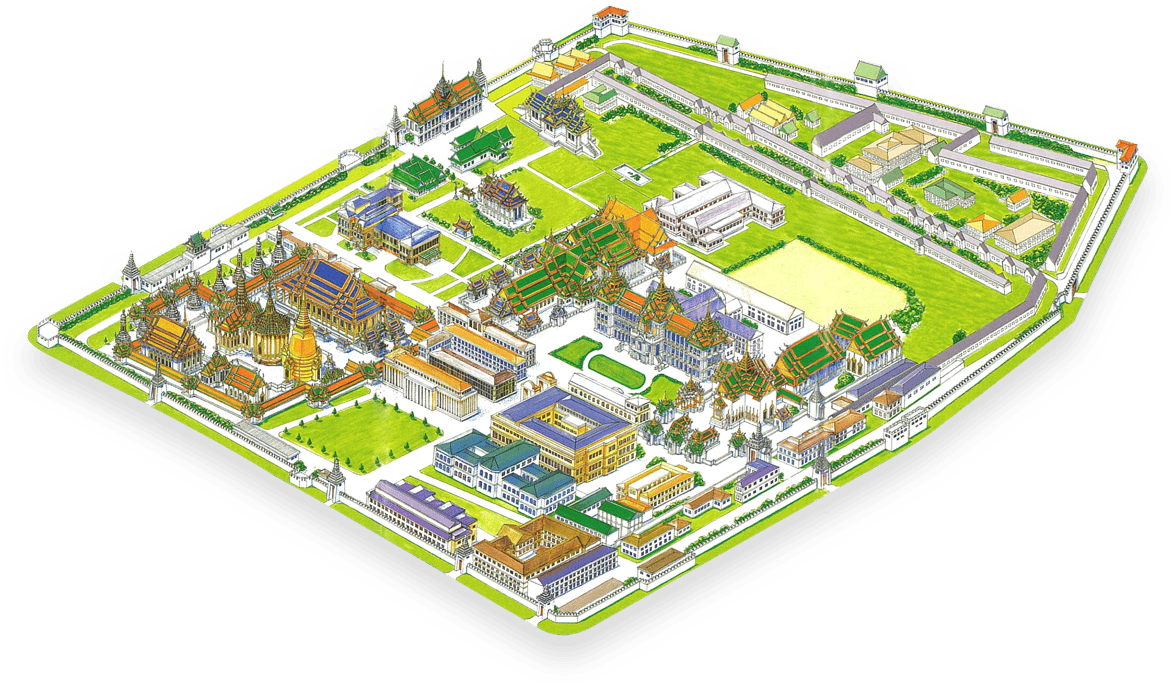
This is a map of the Grand Palace of Bangkok former home of the kings of Siam. As you can see it is not one building, but literally dozens along with shrines, stupas and other symbols of royal authority. Together they constitute by far the biggest tourist attraction in Bangkok and as Alison and I are about to find out, with good reason.
Somewhat surprisingly, the complex is not that old. It was started in 1782 by King Rama I who had just usurped the throne from his long time friend King Taksin who he thanked by having him executed. The long time capital of what was then called Siam had been, since 1350, at Ayutthaya which we will be visiting later on this tour. However, it had been almost completely destroyed by a Burmese invading army in 1767. It was Taksin who managed to literally pick up the pieces of a shattered Siam and through a series of ten campaigns restore the kingdom to an area even larger than present day Thailand. Not wishing to rebuild Ayutthaya, he created a new capital at Thonburi which is upriver from the Grand Palace of Bangkok. In turn Rama I wanted nothing to do with Taksin’s new palace and ordered an entirely new complex to be built on the Chao Phraya River in what was the actual foundation of the city of Bangkok.
Much of the building material was salvaged from the ruins of Ayutthaya and floated downriver to Bangkok. The actual layout of the complex was based on that of Ayutthaya and in effect was a rebuilding of that city at a new location. It was the King’s official residence from 1782 to 1925 and the seat of the administrative and religious functions until 1932 when the monarchy was overthrown. However, it was not abolished and persists today as a constitutional monarchy with King Rama X on the throne. While pictures of him and his queen are everywhere in Thailand, the king himself is not. He prefers to live in Germany along with his many mistresses and thirty poodles which, not surprisingly, is the subject of much consternation back in Bangkok.
So we won’t be bothering the king as we start our tour of the Grand Palace of Bangkok.
The entire complex is surrounded by high walls with only a few entrances. Near the tourist entrance you pass by this portrait of Bhumibol Adulyadej who thankfully in English we call King Rama IX. At the time of his death in 2016 he was the longest reigning monarch in the world, having ascended the throne in 1946 after his father was murdered in circumstances that have never been satisfactorily explained. Unlike his father and his son who preferred to live in Europe, Rama IX spent almost all his time in Thailand after his coronation and like Queen Elizabeth II became a much revered figure during his lifetime and even more so after his death.
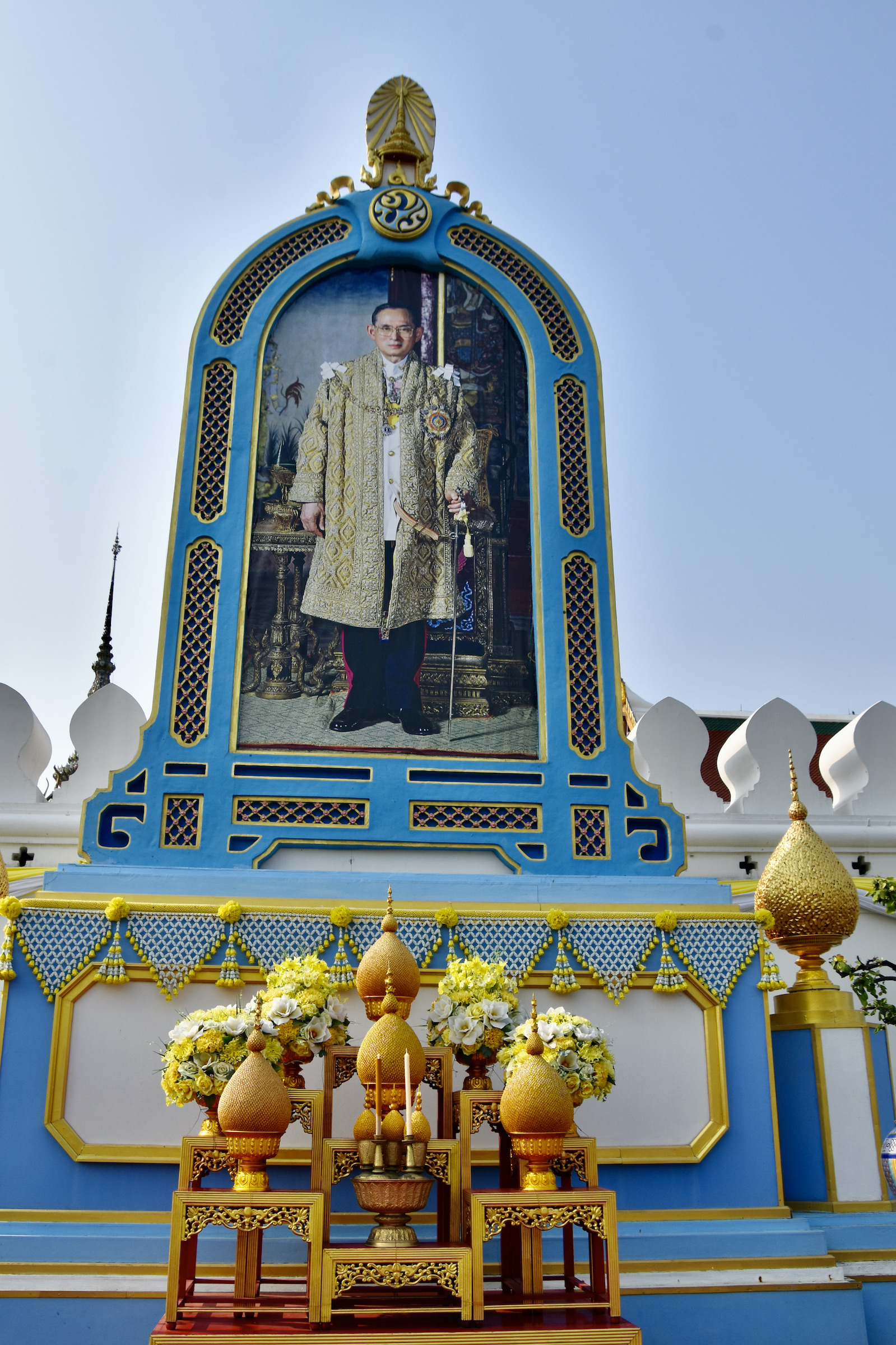
After our guide Su pays the 500 Baht admission fee which is just under $15 USD we are permitted to enter these once sacred grounds. The first place Su takes us also happens to be the most sacred spot within the Grand Palace, Wat Phra Kaew or in English, The Temple of the Emerald Buddha. BTW the word ‘wat’ simply means ‘temple’ and we’ll be seeing it over and over again on this Southeast Asia tour.
The temple and its grounds which contain a myriad of statues, stupas and other interesting sights is surrounded by an interior wall which you can see on the far left of the map. Entering, my eye is immediately drawn to the colourful mural that is painted on the inner side of this wall.
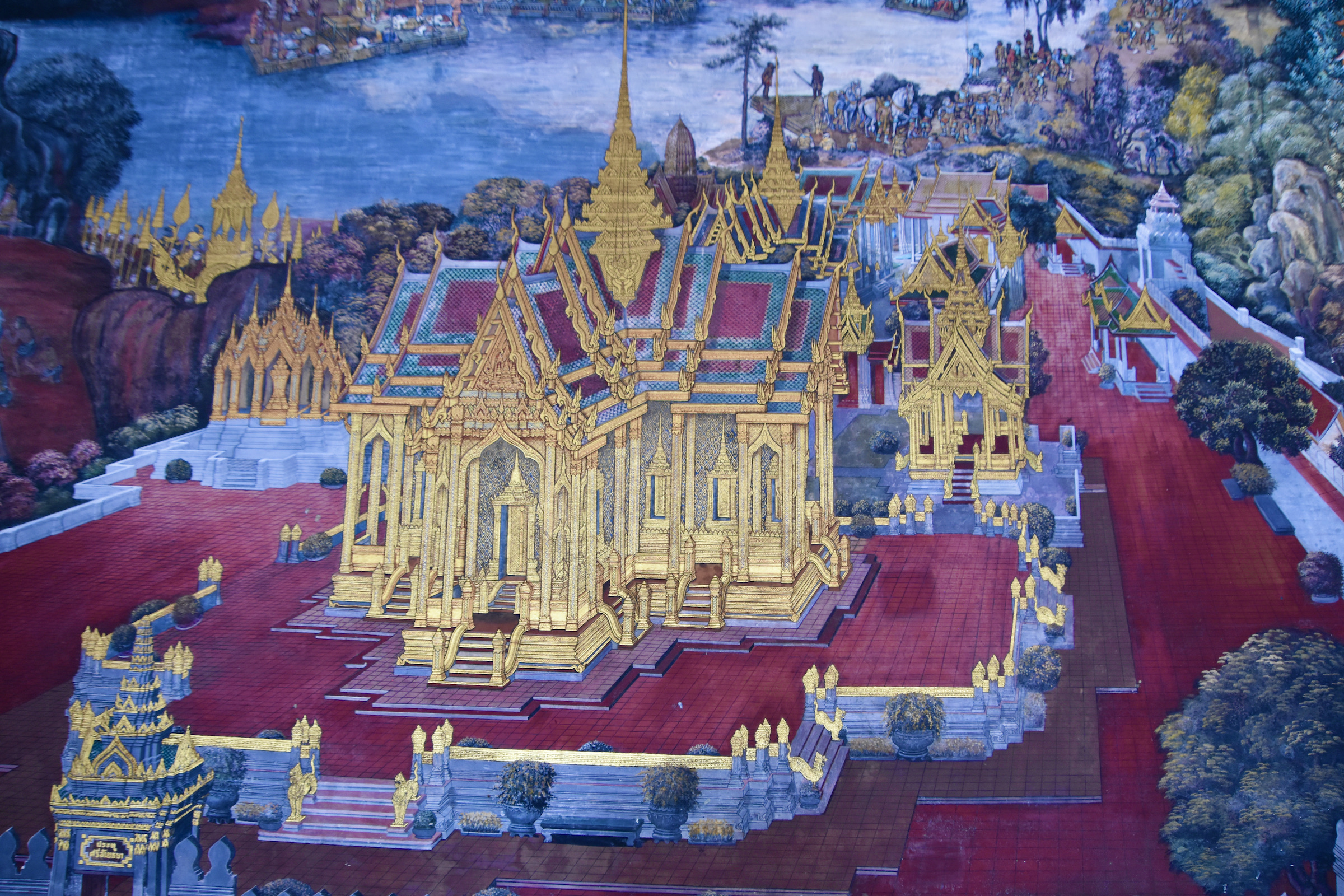
It is in fact one of the great works of art that one can see anywhere in this part of the world and serves as a great introduction into the incredibly complex subject of religion in not only Thailand, but from India to almost all the lands to the east of it. Incredibly, the mural stretches for over two kilometres (1¼ miles) around the wall and presents the story of the Ramakien in 178 distinct panels. This is one of many depictions of royal palaces found in the mural that are remarkably similar to the actual buildings in the Grand Palace of Bangkok.
So what is the Ramakien and why is it important? It is the national myth of Thailand which has a very long oral tradition, but was actually only put into words by King Rama I at the same time as he was building this place. The mural is a contemporaneous exposition of the story which tells one of the great themes in human history – the fight between good and evil. In the Thai version King Rama is scheduled to be the next king of Ayutthaya, when his wife Sida is kidnapped by the demon king Tosakanth. Long story short, Rama enlists the help of Hanuman, King of the Monkeys and together they defeat the demon army, free Sida and everyone but the demons lives happily ever after. This battle between monkeys and demons will also recur again and again as we visit temples not only in Thailand, but Laos, Vietnam and Cambodia as well.
Now if you have any familiarity with Hinduism you will recognize the similarity between the events of the Ramakien and the great Indian epic, the Ramayana which tells an almost identical story and dates back as far as the 8th century BCE. The Ramakien is indeed the Thai version of the Ramayana which aside from being associated with Hinduism has Buddhist, Sikh and Jain ties as well. Which brings up the question, what is a basically Hindu story doing on the walls of a Buddhist temple? It turns out that this and other oral stories were first brought to Southeast Asia by Buddhist monks well before the Thai people themselves migrated into the area from southwestern China between the 6th and 11th centuries. The Buddhists had in turn incorporated them into their religion centuries before that.
I’ve written many posts that discuss syncretism or the amalgamation of ideas from various religions into other religions, often creating an entirely new one from the constituent elements. My experience with syncretism up to now had mostly been with the admix of Christianity with the pre-existing religions of the Americas and Oceania. This interplay between animism, Hinduism and Buddhism is entirely new to me and I wish I had studied more about it before embarking on this trip. However, it’s never too late to learn and that’s one of the reasons I love to travel.
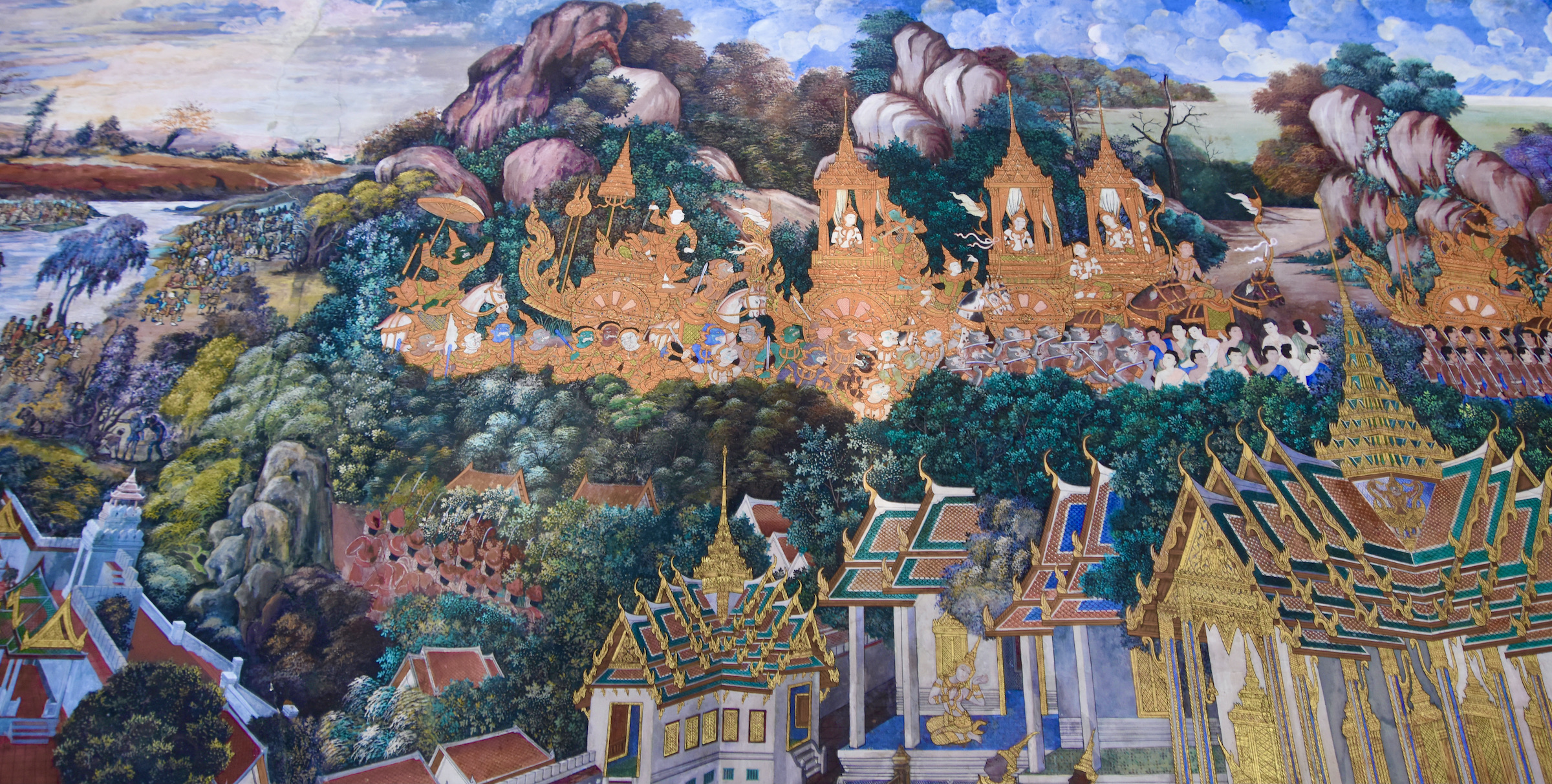
I did learn that the higher up you are on the mural the more important your status and the more you look the more you’ll see. One could spend an entire day looking at the panels on this mural, especially if you knew the Ramakien almost by heart as many Thai people apparently do.
There are seven gates that lead into the Emerald Buddha complex and six are guarded from the inside by giant figures known as yakshas, all of which are individual demons found in the Ramakien. They can be distinguished by the colour of their faces and their individual crowns. They are the first examples of many we will see of not only the beautiful craftsmanship that goes into making these figures, but the elaborate paint jobs they require to keep them as fresh looking as these two. Staring back at them was the first time I think I realized that we were in a totally different culture than any I had previously experienced. Yes, I had seen images like this many times, but never come face to face with them on their own turf.
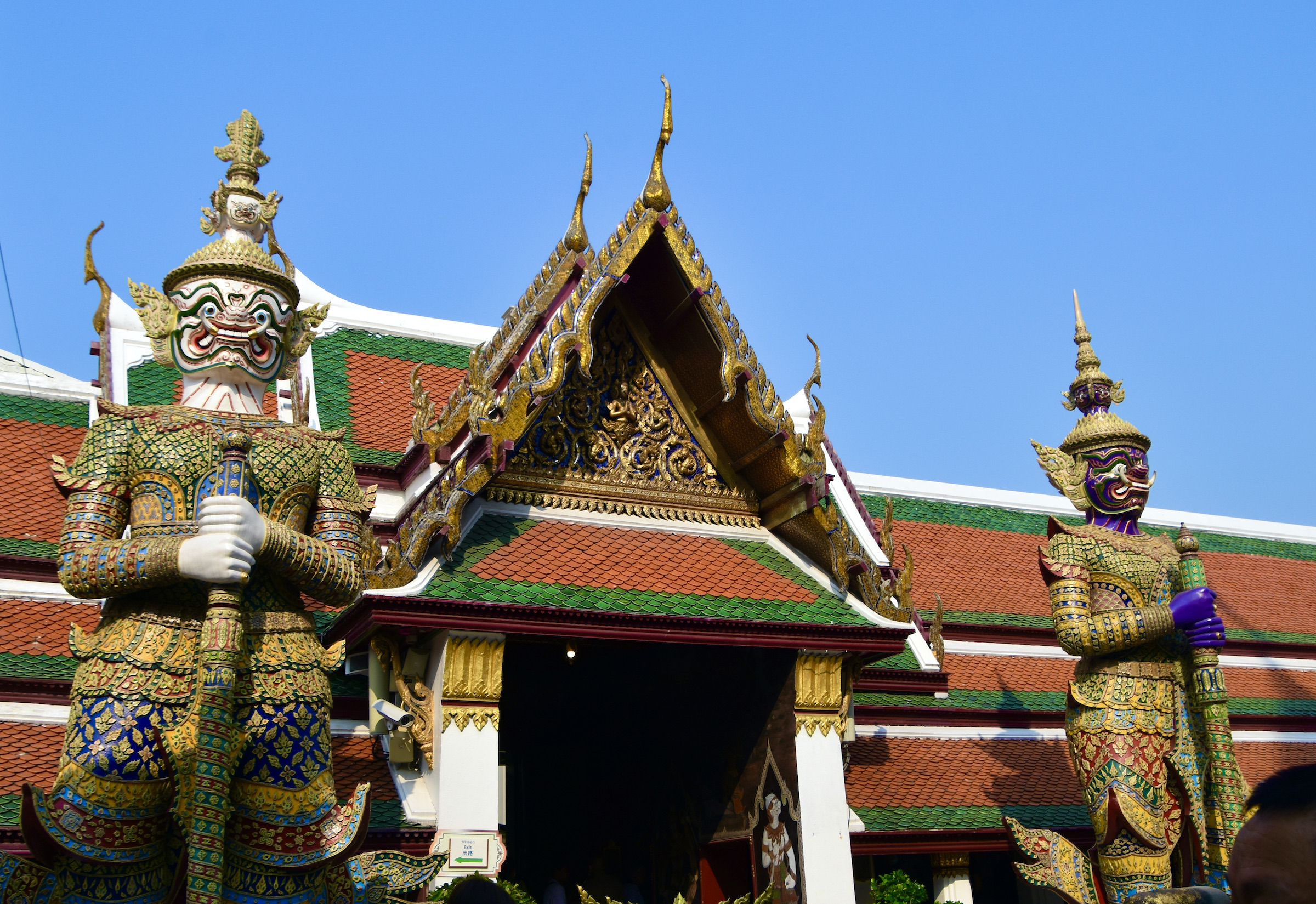
Turning 180° from these guardians you are immediately struck by another piece of architecture that you will only see in this part of Asia, the stupa. These are buildings associated primarily with Buddhism and originally built as reliquaries for items associated with Buddha or other prominent followers. This one is modelled after one in Ayutthaya that in turn was modelled on one in Sri Lanka. It turns out that Christianity and Islam are not the only religions awash in ‘genuine’ relics. Even though Buddha was cremated, umpteen places claim to have parts of his body while others have enough of his ashes to reconstitute an elephant. I am not able to say what particular relics of the Buddha are stored in this building officially known as Phra Si Rattanna Chedi, but like the giant guardians, nothing says exotic like a beautiful golden stupa.
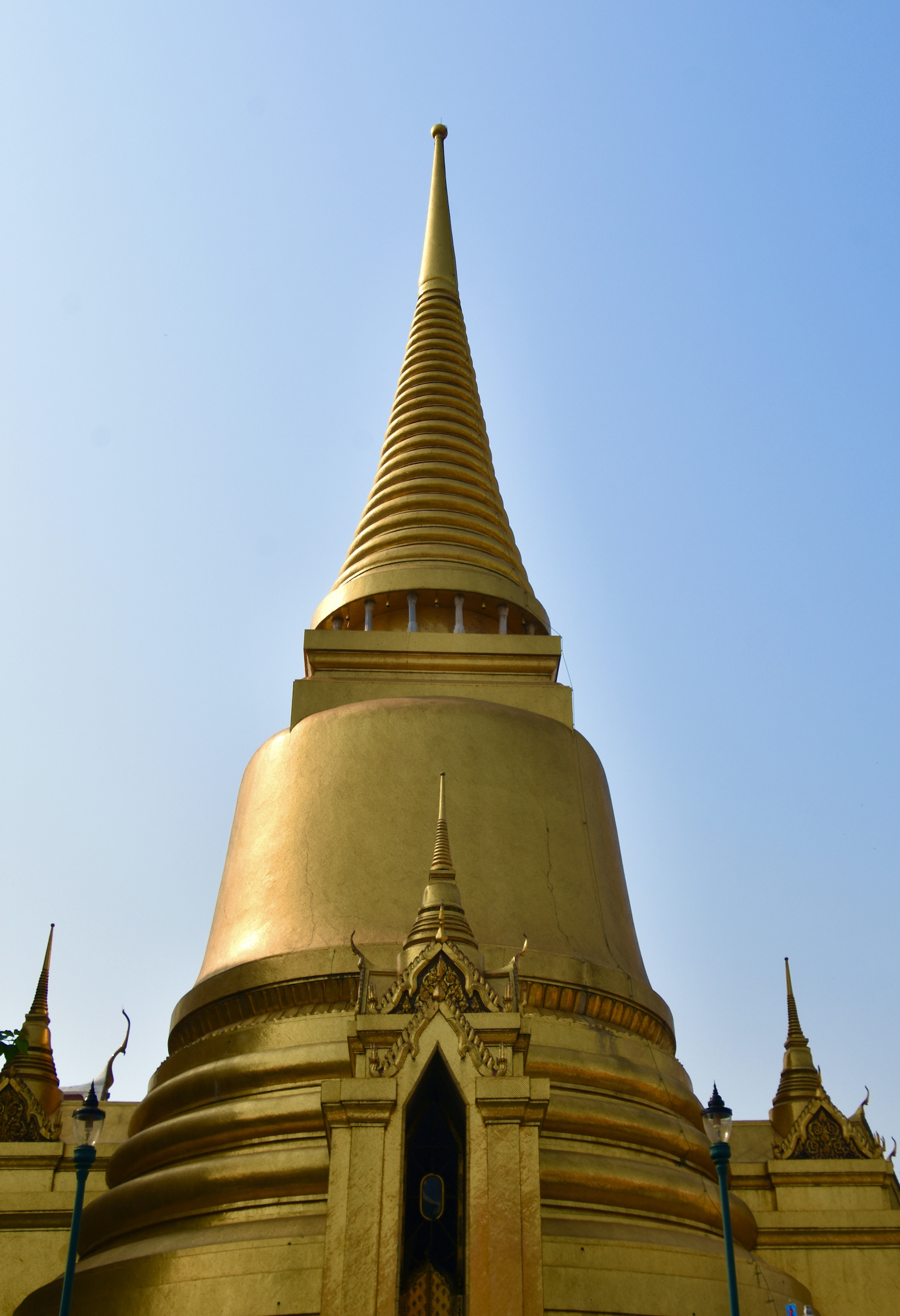
Even though we got here at opening time it was a very busy day at the Grand Palace of Bangkok.It was the Buddhist holiday known as Māgha Pūjā which seems to be almost the equivalent of Easter to Christians. It’s maybe the one day of the year that every god fearing Buddhist must attend at a temple and there’s no more important a temple in Thailand than the one housing the Emerald Buddha. It was for that reason we didn’t actually get to see the Emerald Buddha which looks like this. No there aren’t three of them, but his finery is changed three times a year to reflect the season. On the left is his summer apparel, in the middle his rain gear and on the right his winter coat. I presume he would have had his summer suit on if we had got in to see him.
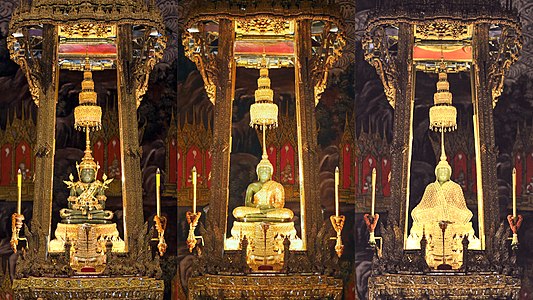
It is not made from a giant emerald, but rather jasper and the name comes from its green appearance. The figure has a well traveled past allegedly going all the way back over 2,000 years although historical records of its existence don’t appear until much later. According to legend it was created in India with the help of the Hindu gods Vishnu and Indra before being sent to Sri Lanka, then Cambodia, Thailand and Laos. Historically, we know it was documented as existing in a stupa in Chiang Mai in northern Thailand from the late 1400’s until 1552 when it was taken to the city of Luang Prabang in Laos where later on this tour we will see the Temple of the Emerald Buddha there, but not the statue. In 1564 the Laotian king moved it to Vientiane where it remained for over 200 years. We will also visit the Temple of the Emerald Buddha there as well, sans Buddha. In 1779 General Chao Phraya Chakri, later King Rama I, invaded Laos and brought the Emerald Buddha back to Thailand and after overthrowing his predecessor and becoming king, installed it in its present location in this temple.
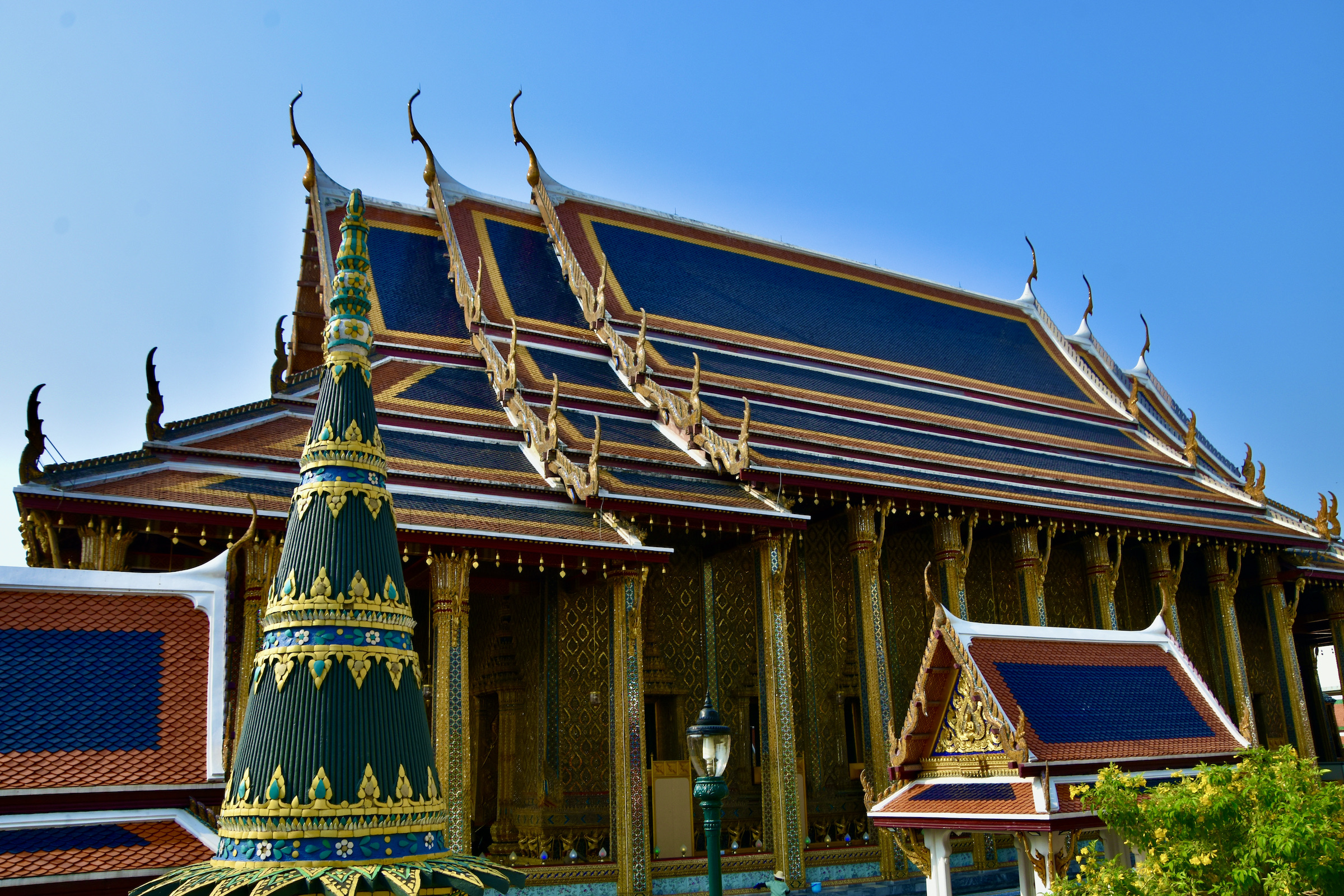
So if you do get to the Grand Palace of Bangkok and get a chance to stand before the Emerald Buddha you will be seeing one of the most iconic and important images in the entire Buddhist religion, one that plays a role in the iconography of half a dozen countries. If you don’t get to see it, you can console yourself with the many other interesting things to see here, as we did. The conical green and gold structure in from of the temple is called a Panom Mak sculpture which alludes to traditional offerings of banana leaves and flowers.
The grounds of the Grand Palace of Bangkok have many statues like these spread throughout the grounds, but they are not your ordinary decorative works of art. I was surprised to learn from Su that these were originally created to be used as ballast for ships returning from China carrying light cargoes such as tea and silks. Once the voyage was over they were simply discarded and it was only in 2022 that trove of over 100 of them were uncovered beneath the palace grounds. Recognizing their value as works of art they were cleaned up and put on display in places like this.
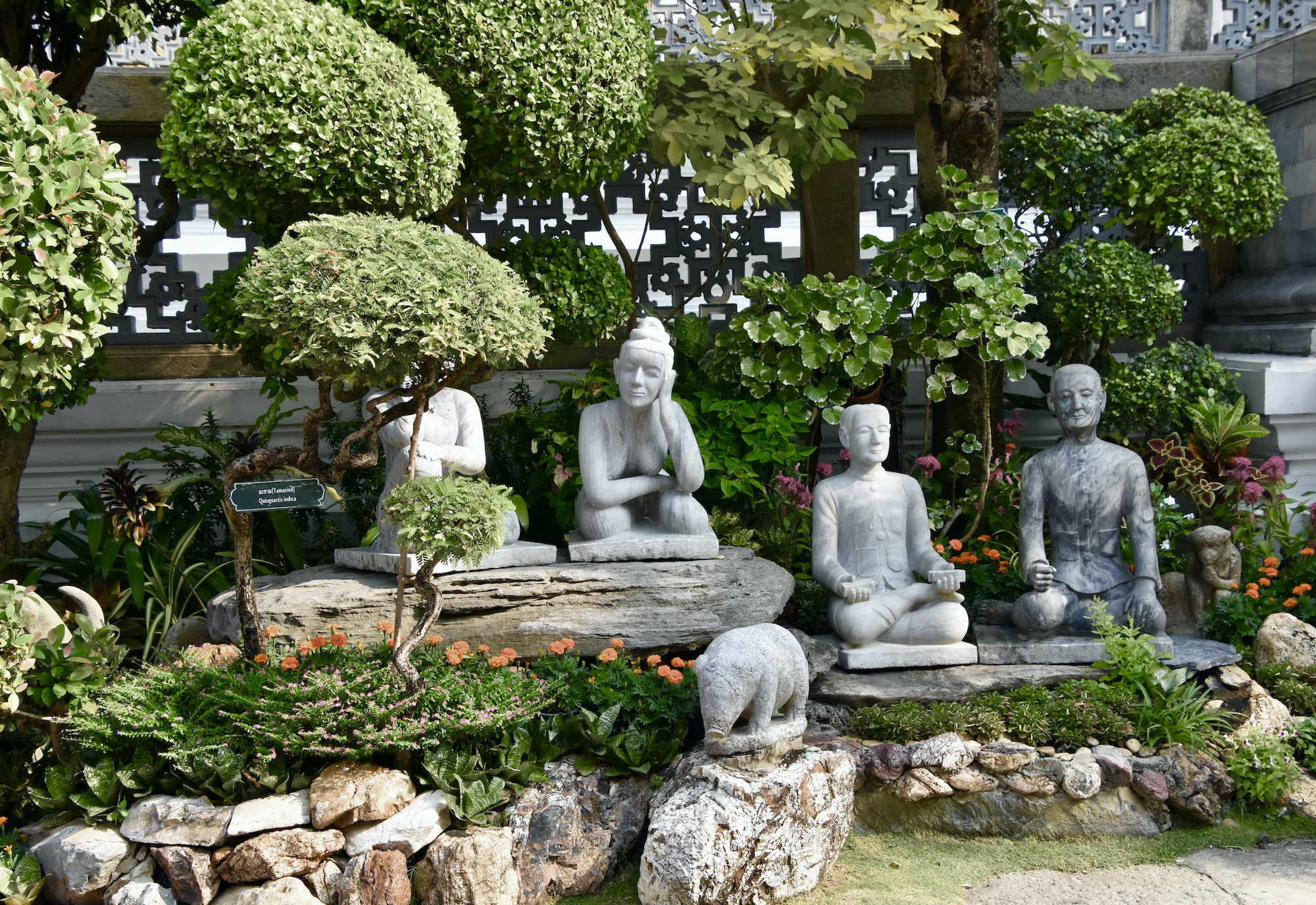
This one, carved from soapstone, represents a Chinese warrior.
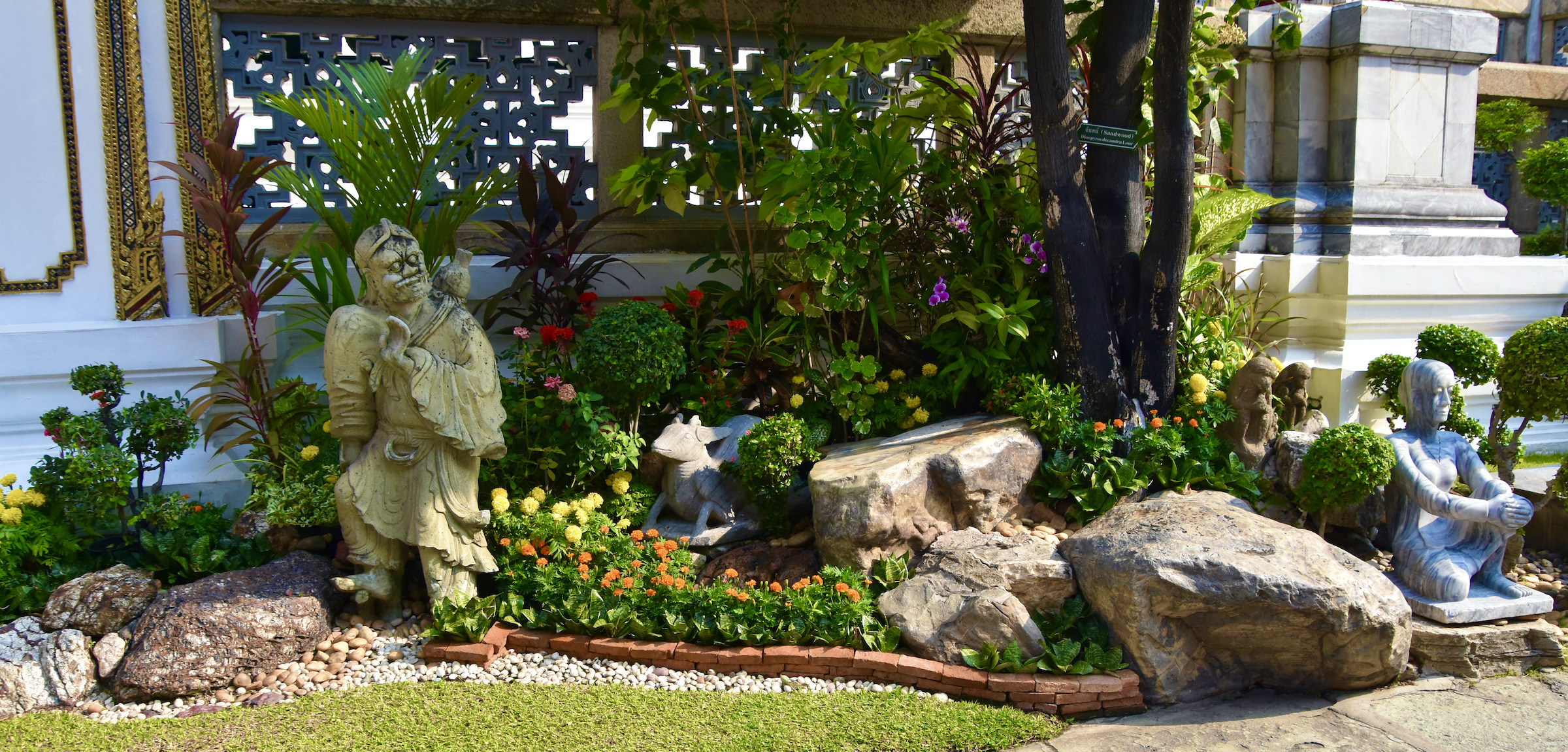
My lesson in Buddhist structures continues as Su points out the building Phra Mondop which is a library containing thousands of scared scrolls. Somehow I always thought of libraries as a western concept, but over the coming weeks we were to see many more libraries associated not only with Buddhism, but other eastern religions as well. It’s certainly one of the most beautiful buildings in the Grand Palace of Bangkok.
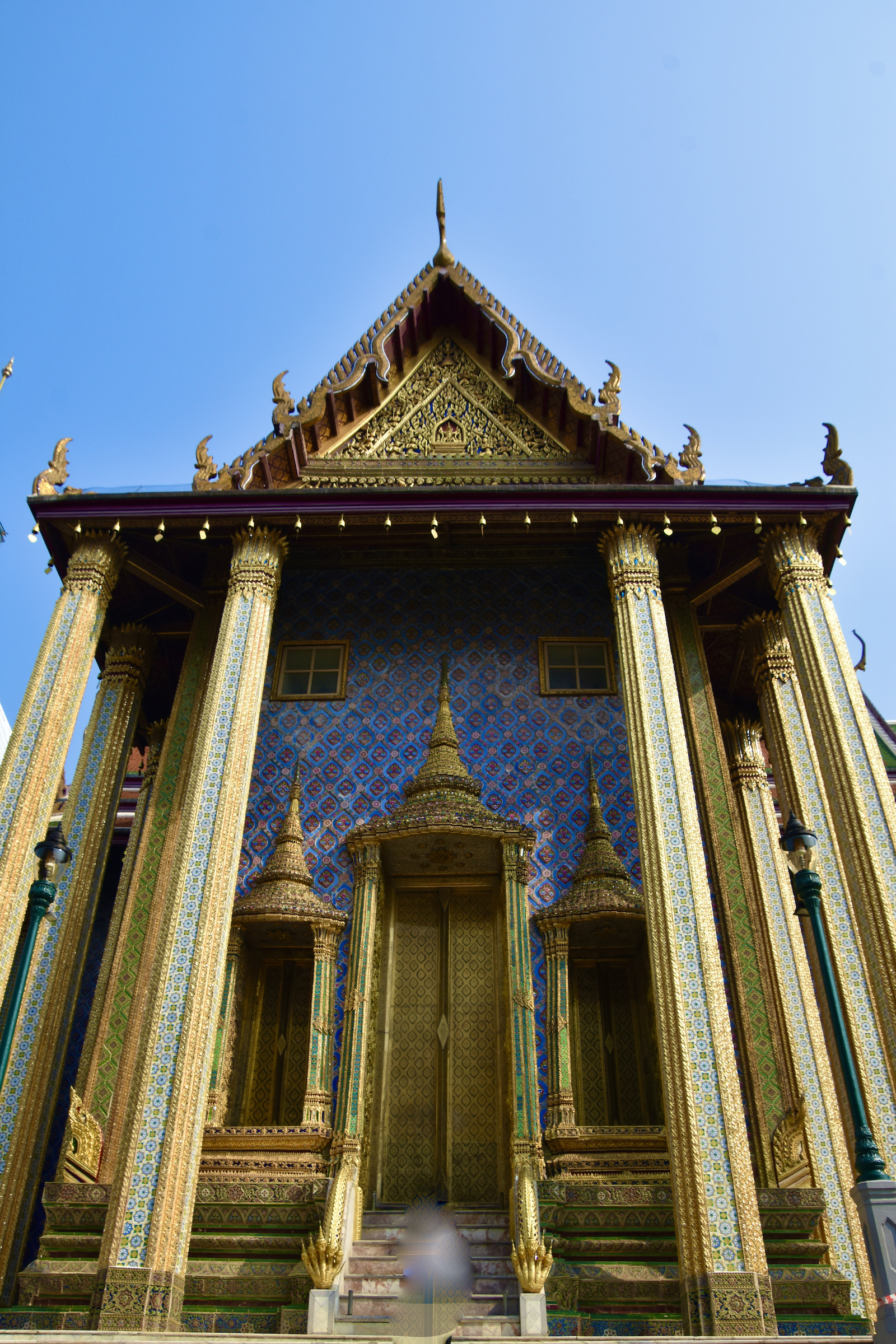
There are seven pairs of fantastic looking mythological figures to be found within the Emerald Buddha complex of which this is one. With the head of a demon and body of a bird this is one of the mythical creatures that haunt the Himavanta Forest that lies at the foot of Mount Meru, the sacred mountain that is considered to be the centre of all three planes of existence in both the Hindu and Buddhist religions. This post is turning into a crash course on Thai beliefs and customs.
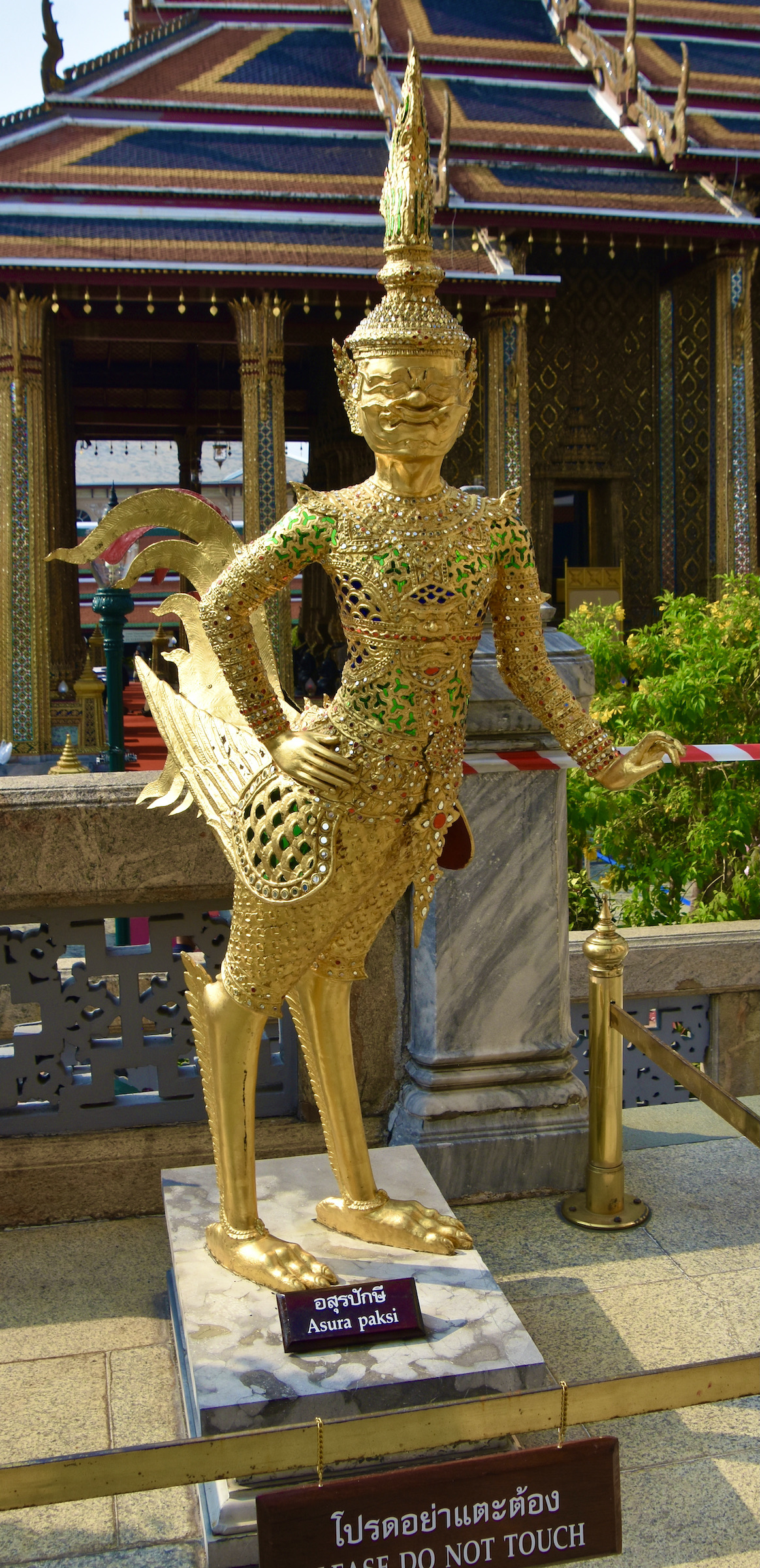
The next building of note within the Emerald Temple enclosure is the Prasat Phra Thep Bidon or Royal Pantheon which was once intended by King Rama IV to house the Emerald Buddha, but he died before it was completed and for a change the Buddha stayed put. The tall spire identifies the building as a prasat, a form reserved for royal residences. Inside are statues of the first nine Rama kings, but it is closed to the public all but one day a year.
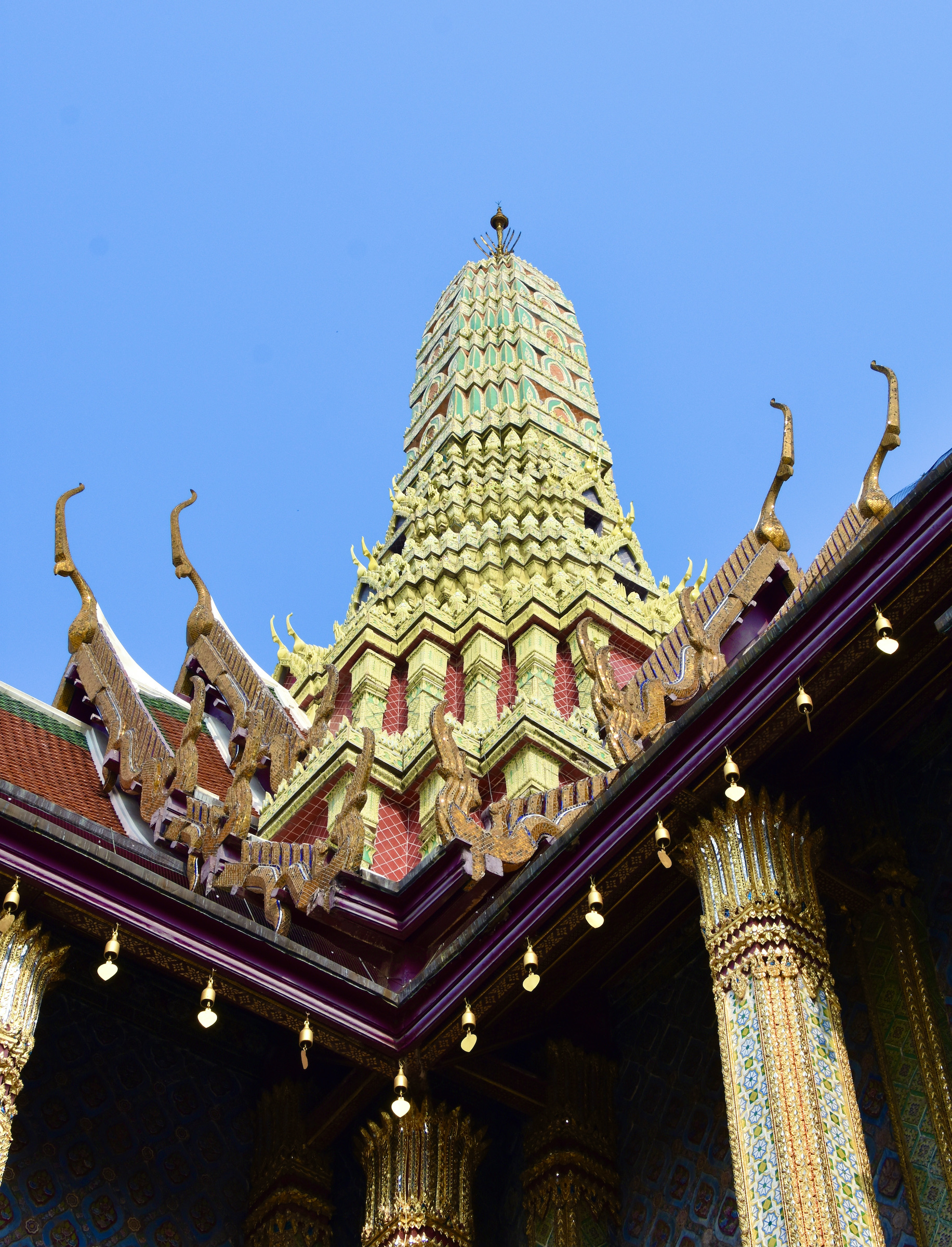
Flanking the Royal Pantheon of the Grand Palace of Bangkok are two golden towers (aka chedis) the Phra Suvarnachedi that Rama I built to commemorate his mother and father. Glittering in the sunlight, they add even more to the overwhelming grandeur of this place.
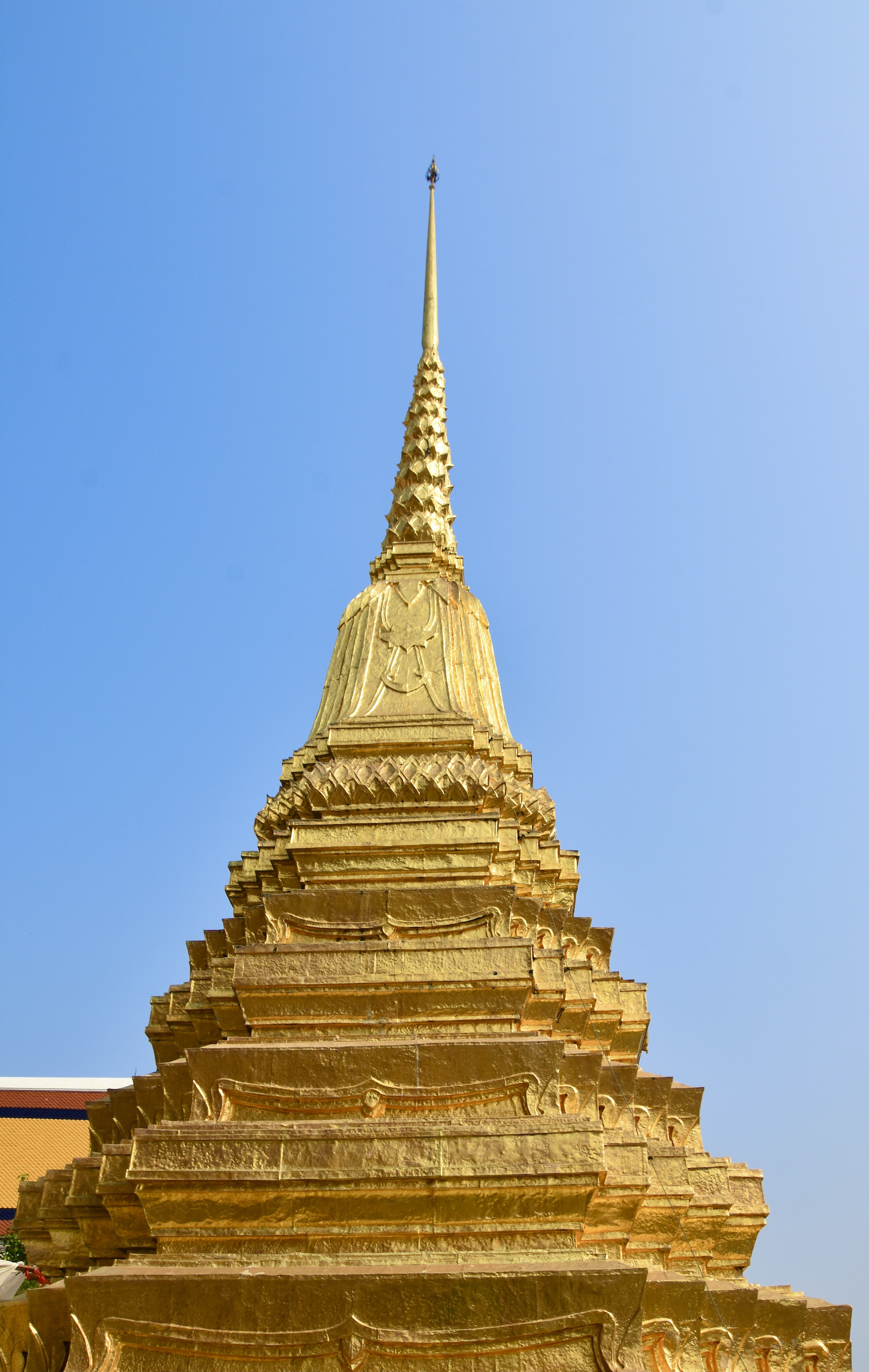
This is even more so when you take a close look at two of the sixteen demon giants apparently holding up the chedi. Everything about the Grand Palace of Bangkok is amazing whether it be large scale such as the buildings themselves or small scale in the details that go into creating those buildings.
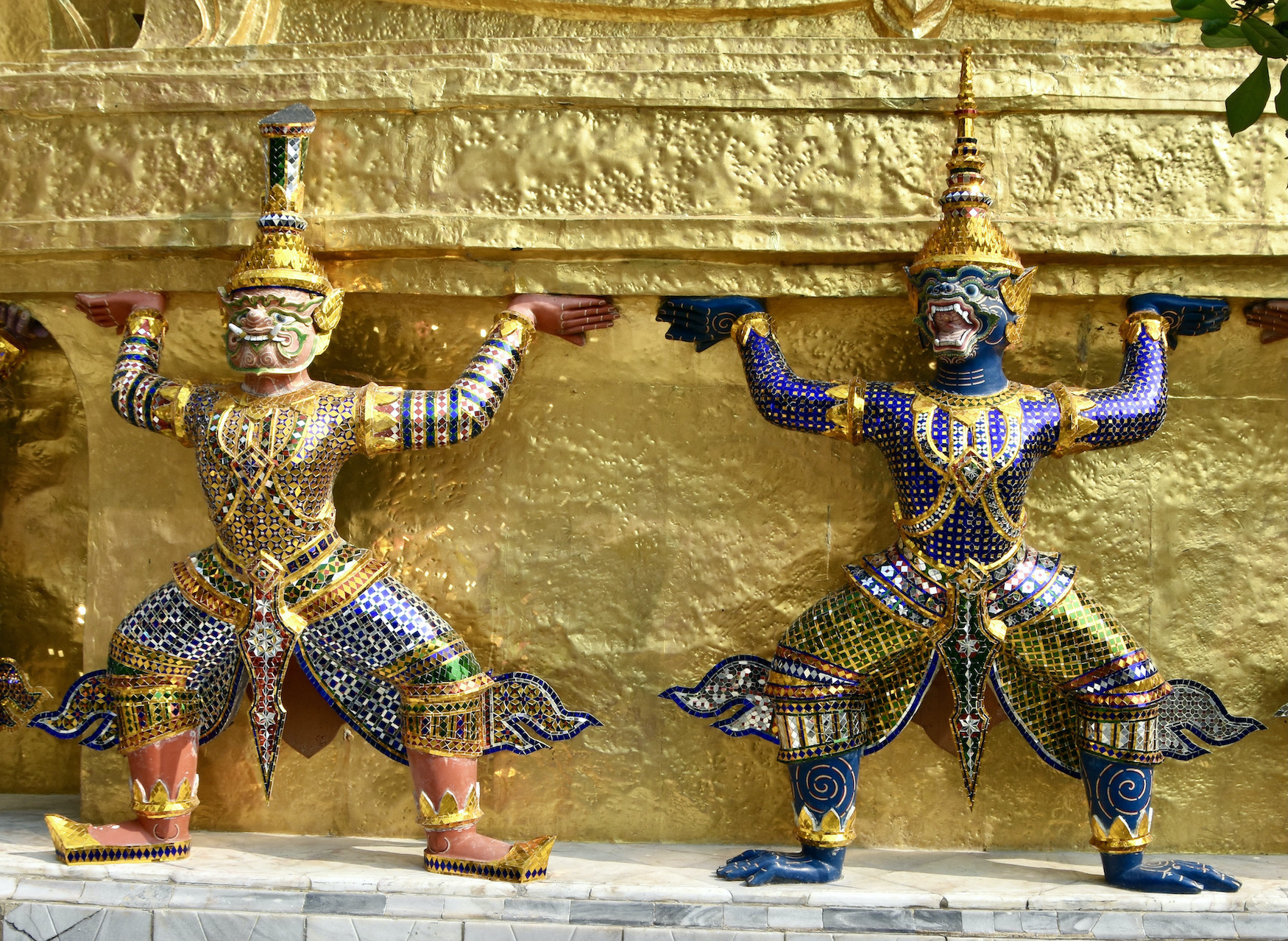
Still we are not finished seeing all the great buildings inside the Emerald Buddha complex as Su points out Phra Wihan Yot with its incredibly ornate spire and almost Moorish appearance. It was built by Rama III to house important images of the Buddha, the collecting and keeping of which is an integral part of the religion as Alison and I will find out as we visit many more temples over the coming weeks.
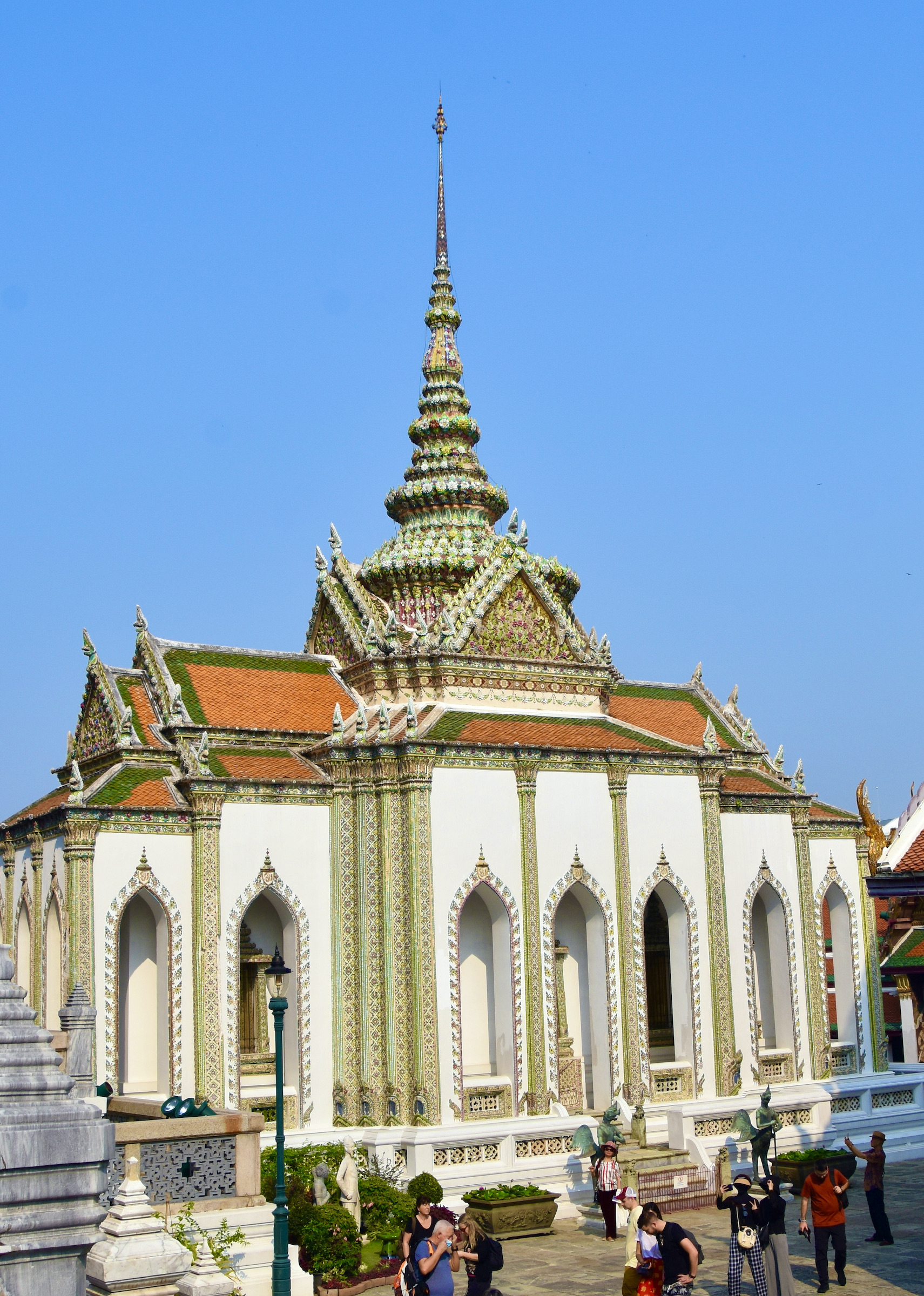
Note the two bronze figures guarding the entrance to the building. This is a close up of one. They are called tantima birds with the head of the Hindu demi-god Garuda, torso of a man and legs and tail of a bird. However, in Buddhism Garudas are more like the rocs of Arabic mythology, giant birds with intelligence. If I thought the Greeks had a great set of mythical beasts I’m starting to get an inkling that the Hindu/Buddhist pantheon of legendary creatures is just as extensive and maybe even much greater.
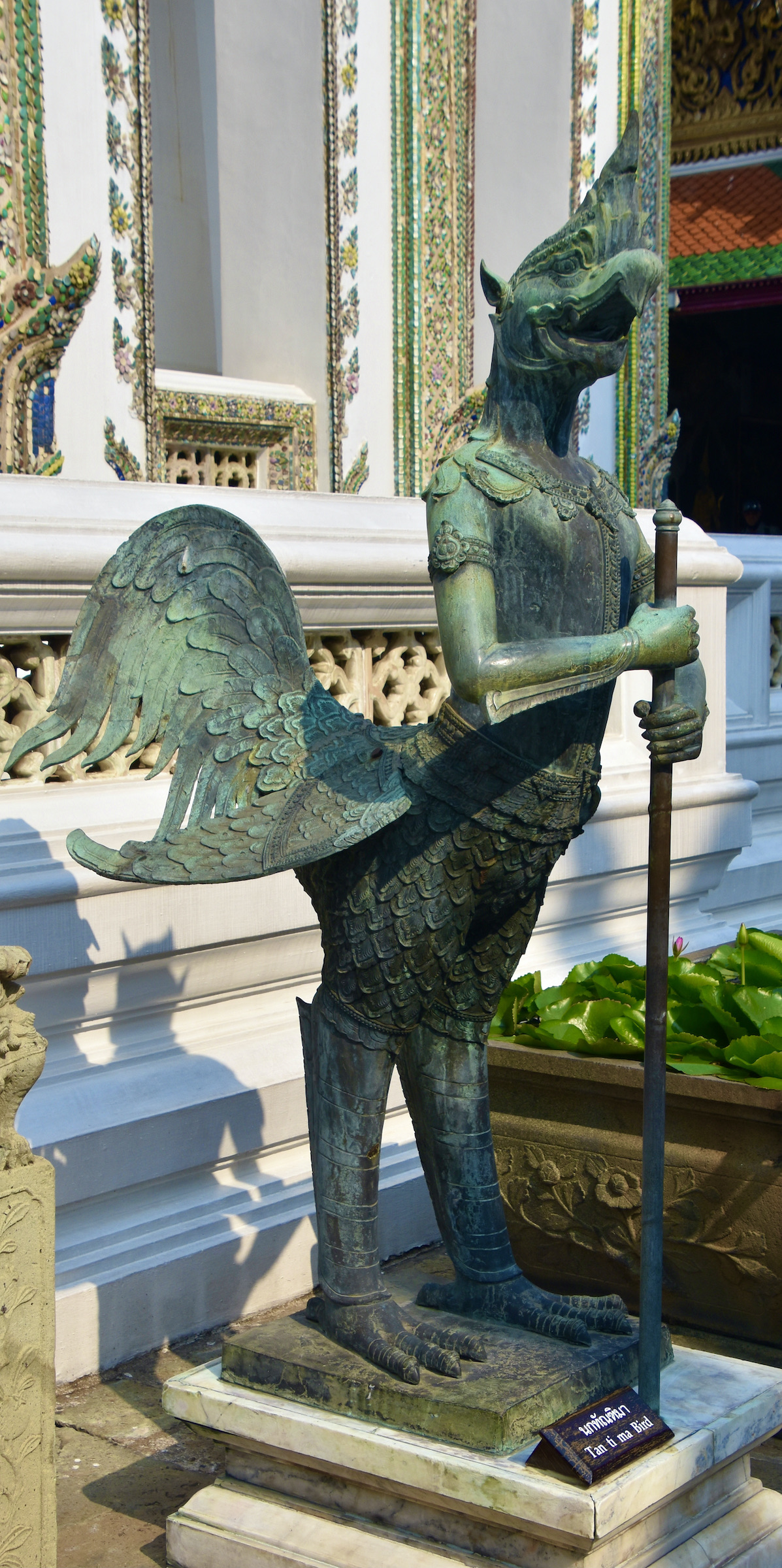
Between the Phra Wihan Yot and the Phra Mondop is this huge model of Angkor Wat which had me asking Su, “What the heck is that doing here?”. It turns out that when French naturalist Henri Mouhot supposedly ‘discovered’ Angkor Wat in 1860 the area was under Siamese control. While many Europeans and others had visited the site before Mouhot, he was the right man at the right time and his descripton of the temples created a sensation not only in the western world, but in Siam as well. King Rama IV wanted to have one of the temples moved to the Grand Palace, but instead settled for this model.
We will visit Angkor Wat later on this trip and I will explain that its creation had absolutely nothing to do with the Thai people, but was entirely the work of the Khmer people hundreds of years before there was even a trace of any Thai civilization in Southeast Asia. So it’s a bit of an anachronism in the Grand Palace of Bangkok.
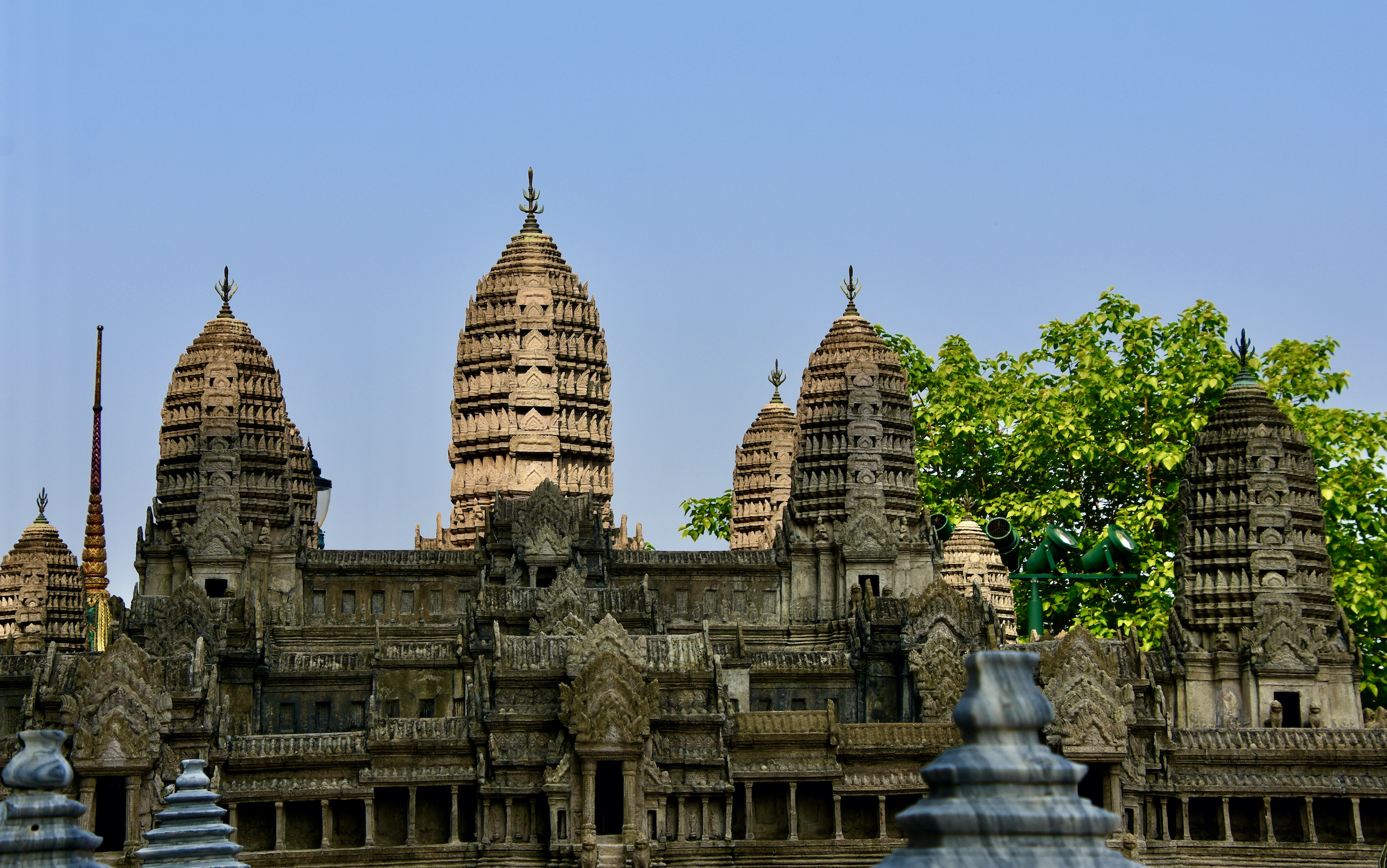
We had now reached the other side of the Emerald Buddha complex and were escorted out by two more giant guardians, Suriyaphop on the left and Intarachit on the right.
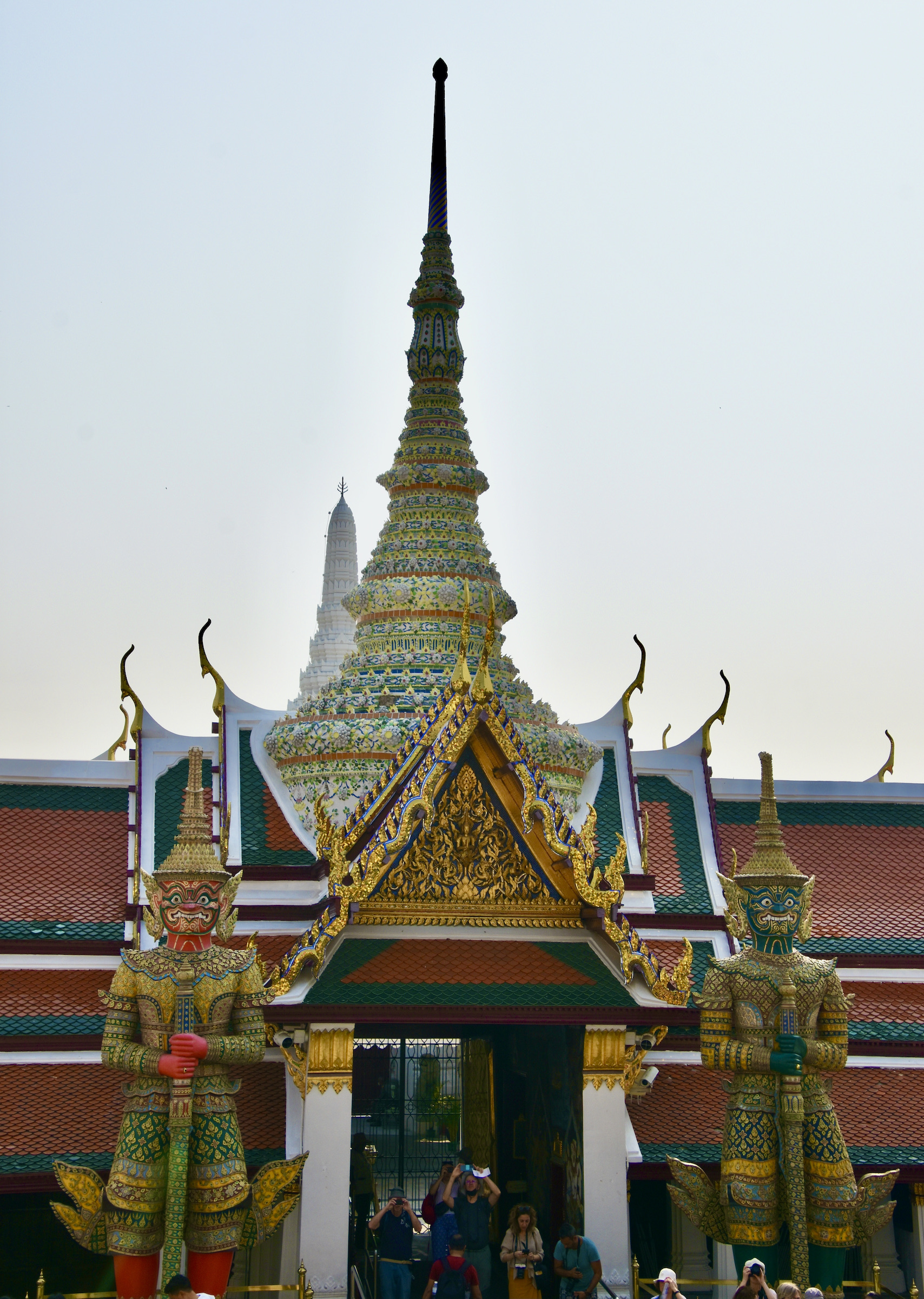
As you can see there are now hordes of tourists pouring and I’m glad we got here at opening time.
This is a look down the colonnade where the Ramakien Mural comes to a finish.
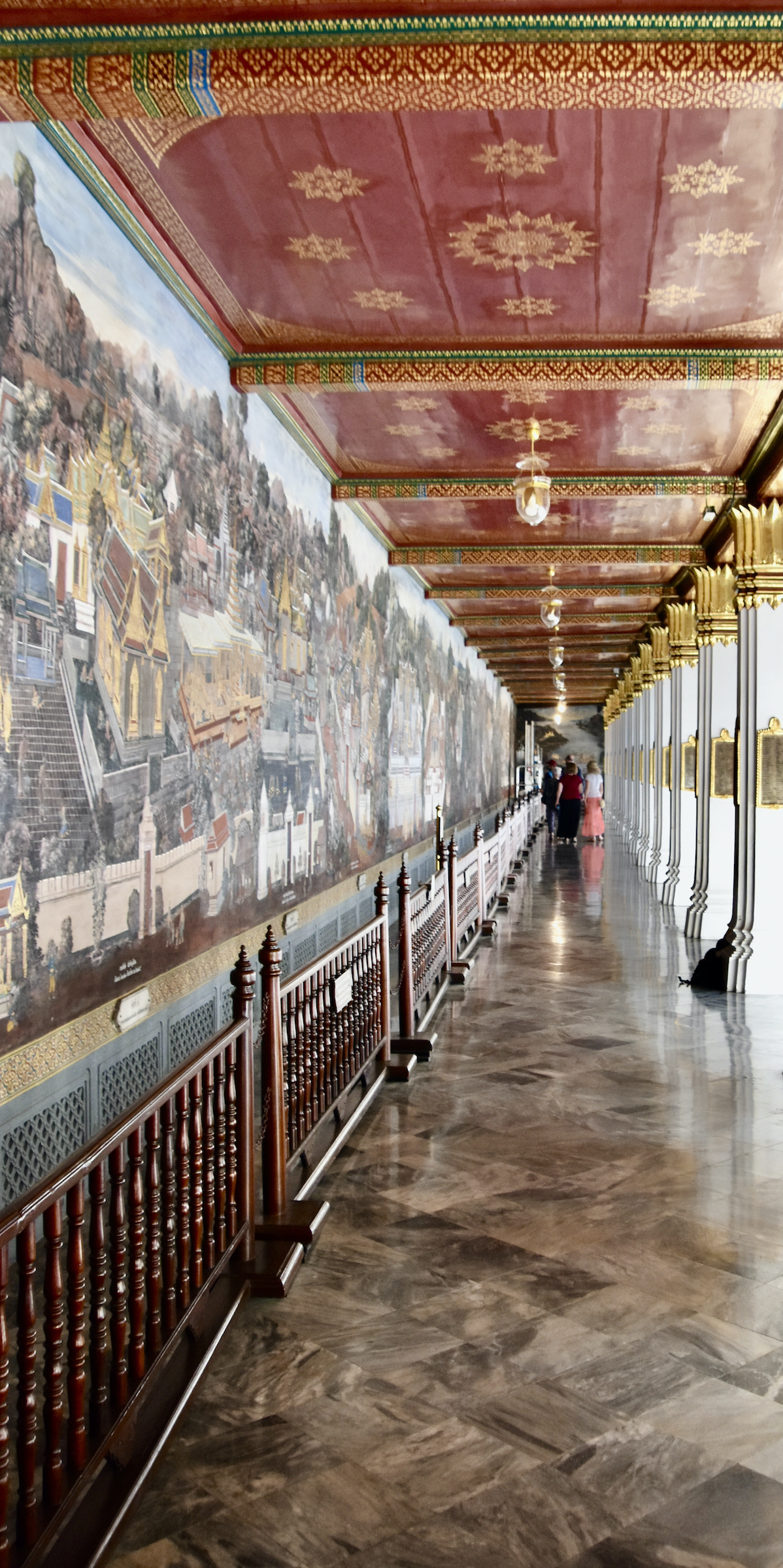
There is also the opportunity to view the first panel that starts on the left side of this entrance. I absolutely love this painting, both for its interesting figures and the symbolism. Su described it as the birth of the first woman, but I don’t think so as those are clearly women on the left side of the panel. I cannot find anything definitive about it, but I think it depicts the birth of Sida who is described in the Ramayana as ‘daughter of the earth’ and this woman, who the king stumbles across while plowing his fields, is coming up out of the earth on a lotus flower. It certainly brings to mind Botticelli’s Birth of Venus where the goddess comes up from the sea on a scallop shell. Whatever it represents, it’s interesting as hell.
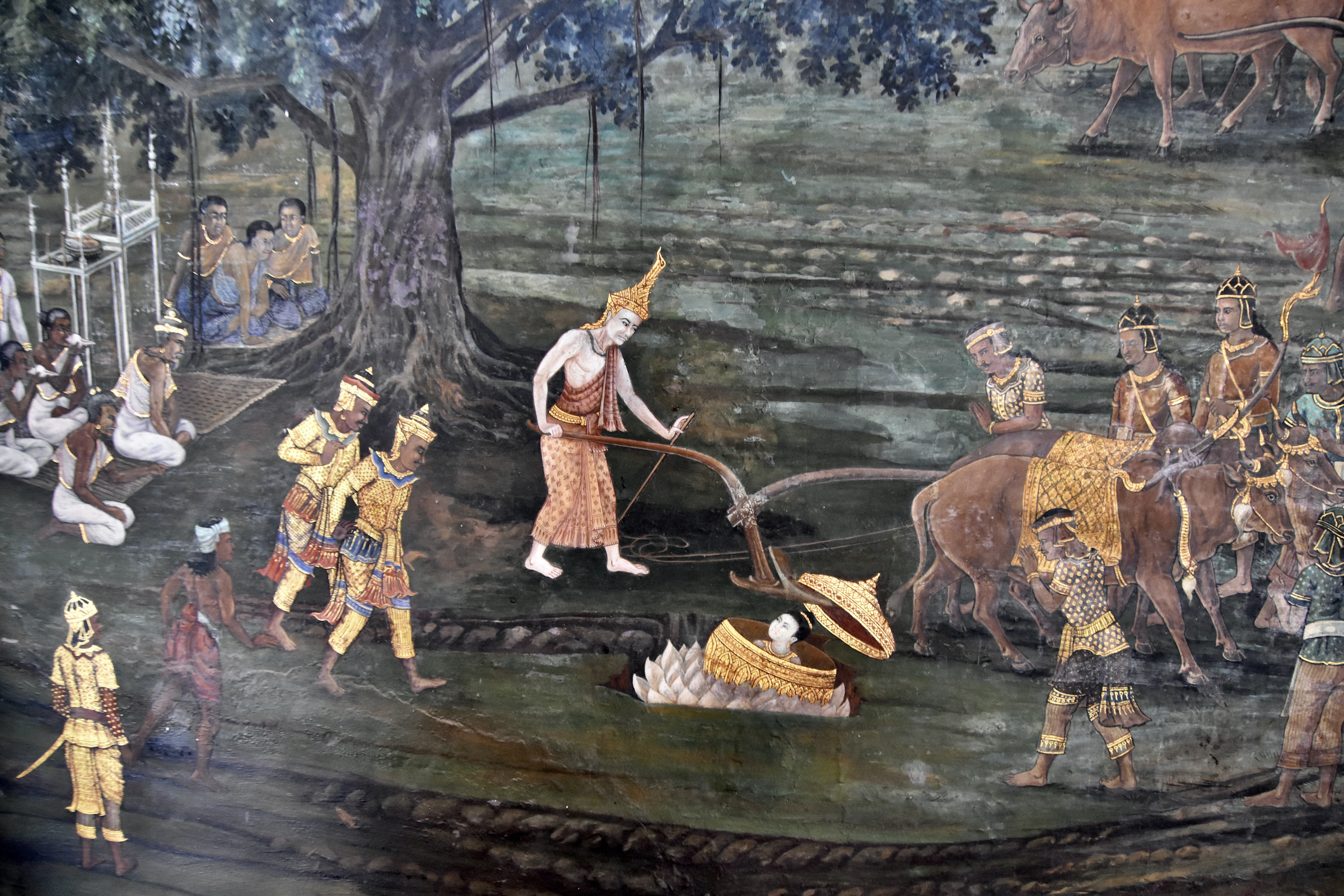
We were now outside the Emerald Buddha area and could have spent a lot more time exploring the Grand Palace of Bangkok, but given our time limited schedule we settled for just one more, the Chakri Masat Throne Hall. It was built as a palace by Rama V who resided there until 1910. The combination of traditional Thai and European architecture is quite unusual and in this case I think it works. It is now used only for ceremonial purposes.
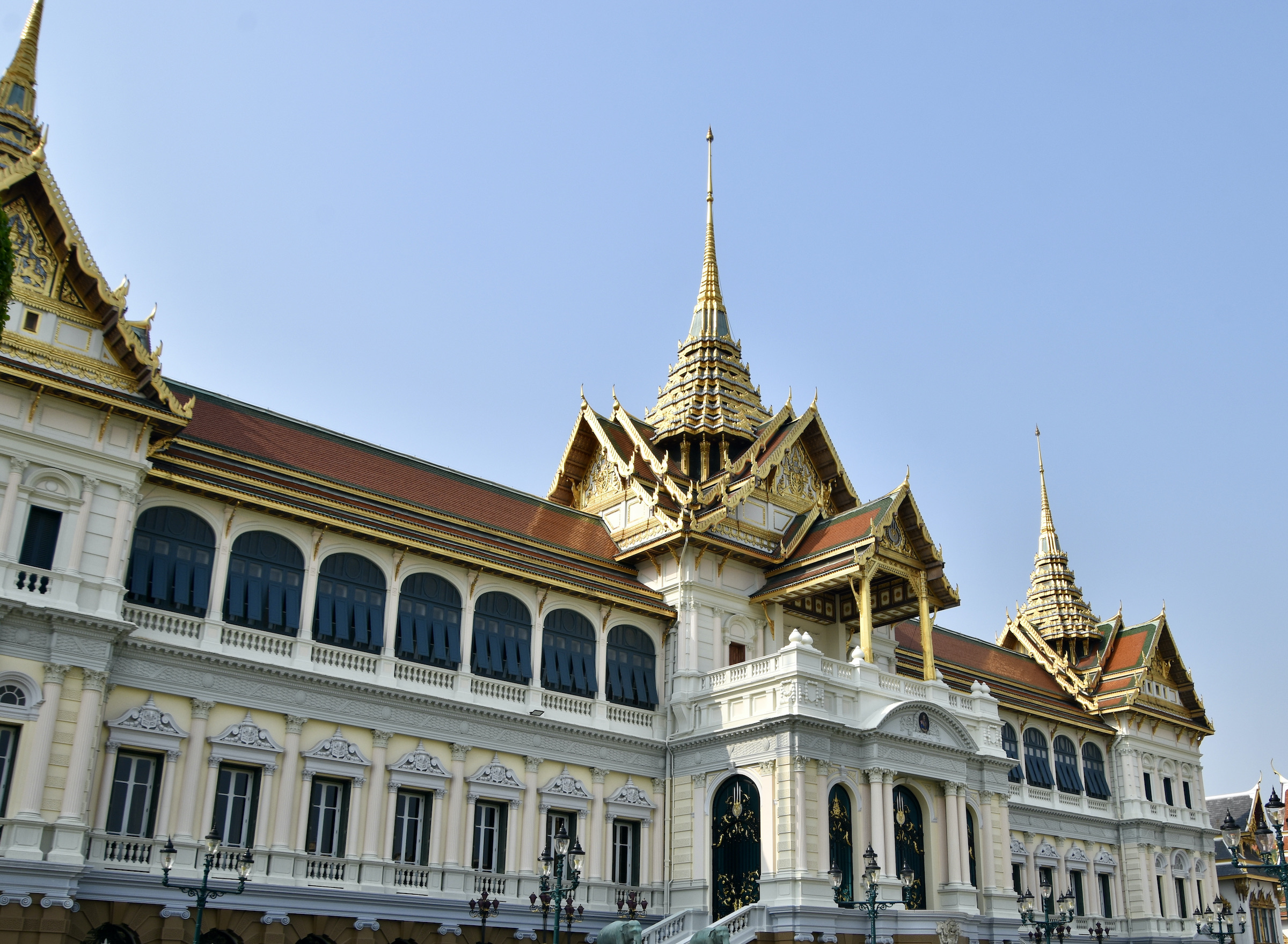
With that we had Su take our picture on the grounds of the Grand Palace of Bangkok and then made our exit.
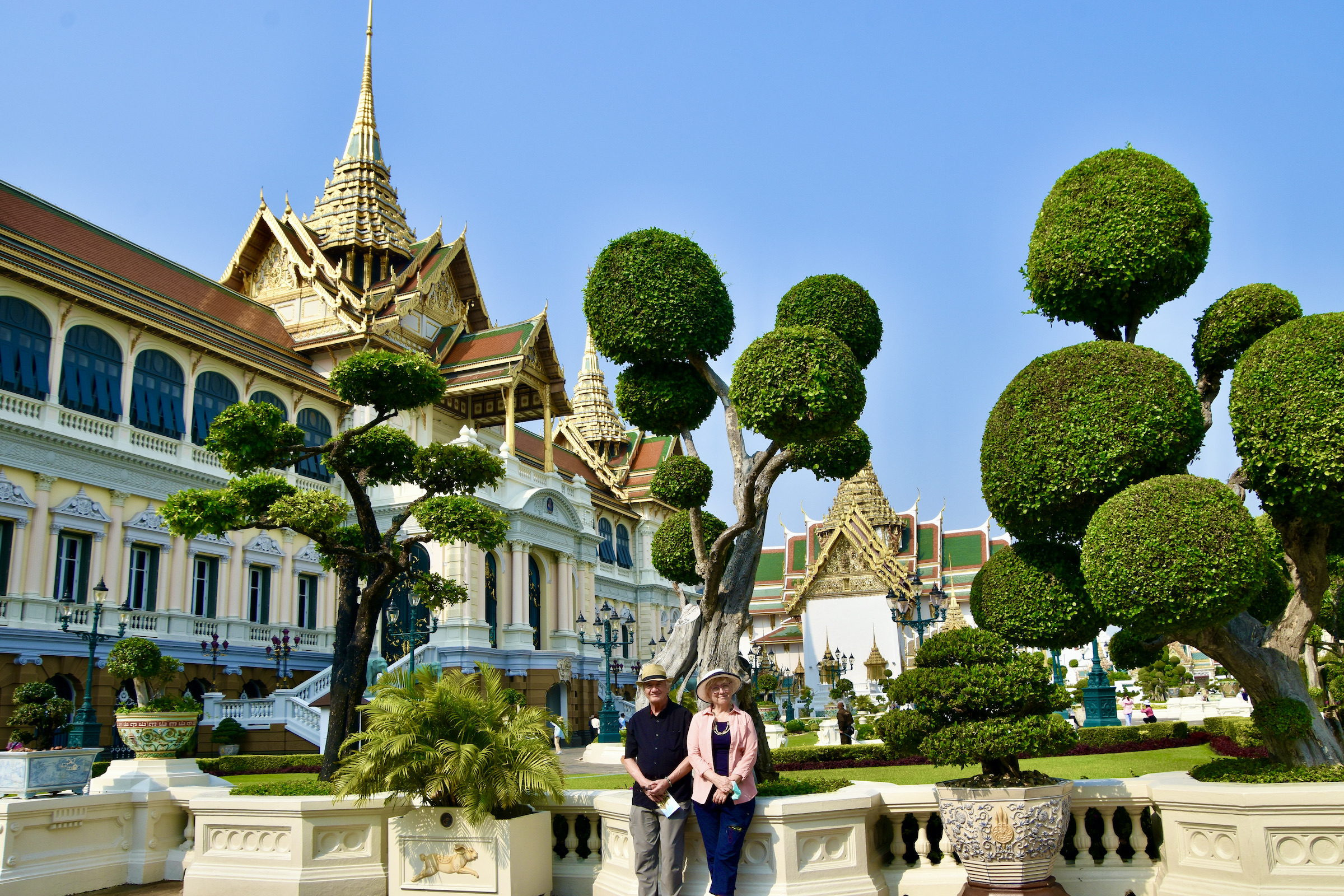
In the next post from Thailand we will leave Bangkok for the day and visit the bridge on the River Kwai as well as taking a trip on the railway built by prisoners of war featured in the famous movie.

